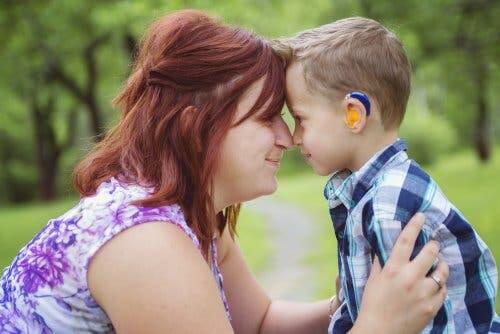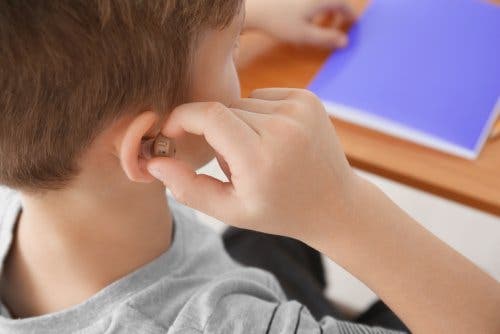The Classification of Hearing Loss in Children


Written and verified by the psychologist Ana Couñago
Hearing loss in children means that they aren’t able to hear as well as someone whose hearing is normal. Thus, according to the World Health Organization (WHO), around 466 million people worldwide have disabling hearing loss, of which 34 million are children.
Therefore, this is a fairly widespread problem that, in addition, implies serious communication limitations. This can have negative effects on people’s daily lives and generate a feeling of loneliness, isolation, and frustration.
“It would appear that serious emotional problems are three-to-six times as common among deaf children as among hearing children and that disturbances of lesser severity are also observed with greater frequency among deaf children.”
– Hilde Schlesinger and Kathryn Meadow –
The classification of hearing loss in children
The classification of hearing loss can be based on four different criteria: the time of appearance, the degree of the loss, the location of the injury, and individual differences. Therefore, depending on the time of appearance of hearing loss, it can be:
- Prelocutive. The injury occurs before language acquisition.
- Perlocutive. It appears during speech learning.
- Postlocutive. When hearing loss occurs once language has been established.

On the other hand, it can be categorized based on the degree of hearing loss. Thus, it could be:
- Mild. If the hearing loss is 20 to 40 dB.
- Moderate. If the hearing loss is between 40 and 70 dB.
- Severe. If the hearing loss is between 70 and 90 dB.
- Profound. If the hearing loss is greater than 90 dB.
Please note that the dB symbol refers to decibels, a unit that measures sound pressure.
A third classification of hearing loss is according to the location of the lesion:
- Conductive. If the injury occurs in the transmission of sound through the outer and middle ear.
- Sensorineural. If the injury occurs in the inner ear or in the auditory nerve pathway.
Finally, for the classification of hearing loss, the individual differences of each child can also be taken into account, such as:
- The time of detection.
- The etiology of the hearing loss.
- Intellectual capacity.
- The family atmosphere.
- Economic availability.
- The quality of communication.

The detection of hearing loss in children
At birth, babies undergo an acoustic test to rule out hearing problems. But, as you’ve already seen, hearing loss can manifest throughout the child’s development. Thus, to detect hearing difficulties in children and make an early diagnosis, a specialized electromedical team has to carry out audiometry exam tests.
In this sense, one of the possible tests that can evaluate a hearing problem is tone audiometry. This is a test that codes hearing alterations in relation to acoustic stimuli and whose results are recorded on an audiogram.
The method consists of the child entering a soundproof booth and listening to a series of sounds through headphones. Then, they must indicate whether they perceive them by raising one of their hands. The professional decreases the volume of these sounds until they become inaudible for the child. After that, they determine the hearing threshold and the type of hearing problem.
In short, early detection is essential to avoid as many consequences of hearing loss as possible. Also, these children need to go to speech therapy intervention sessions as soon as possible.
Hearing loss in children means that they aren’t able to hear as well as someone whose hearing is normal. Thus, according to the World Health Organization (WHO), around 466 million people worldwide have disabling hearing loss, of which 34 million are children.
Therefore, this is a fairly widespread problem that, in addition, implies serious communication limitations. This can have negative effects on people’s daily lives and generate a feeling of loneliness, isolation, and frustration.
“It would appear that serious emotional problems are three-to-six times as common among deaf children as among hearing children and that disturbances of lesser severity are also observed with greater frequency among deaf children.”
– Hilde Schlesinger and Kathryn Meadow –
The classification of hearing loss in children
The classification of hearing loss can be based on four different criteria: the time of appearance, the degree of the loss, the location of the injury, and individual differences. Therefore, depending on the time of appearance of hearing loss, it can be:
- Prelocutive. The injury occurs before language acquisition.
- Perlocutive. It appears during speech learning.
- Postlocutive. When hearing loss occurs once language has been established.

On the other hand, it can be categorized based on the degree of hearing loss. Thus, it could be:
- Mild. If the hearing loss is 20 to 40 dB.
- Moderate. If the hearing loss is between 40 and 70 dB.
- Severe. If the hearing loss is between 70 and 90 dB.
- Profound. If the hearing loss is greater than 90 dB.
Please note that the dB symbol refers to decibels, a unit that measures sound pressure.
A third classification of hearing loss is according to the location of the lesion:
- Conductive. If the injury occurs in the transmission of sound through the outer and middle ear.
- Sensorineural. If the injury occurs in the inner ear or in the auditory nerve pathway.
Finally, for the classification of hearing loss, the individual differences of each child can also be taken into account, such as:
- The time of detection.
- The etiology of the hearing loss.
- Intellectual capacity.
- The family atmosphere.
- Economic availability.
- The quality of communication.

The detection of hearing loss in children
At birth, babies undergo an acoustic test to rule out hearing problems. But, as you’ve already seen, hearing loss can manifest throughout the child’s development. Thus, to detect hearing difficulties in children and make an early diagnosis, a specialized electromedical team has to carry out audiometry exam tests.
In this sense, one of the possible tests that can evaluate a hearing problem is tone audiometry. This is a test that codes hearing alterations in relation to acoustic stimuli and whose results are recorded on an audiogram.
The method consists of the child entering a soundproof booth and listening to a series of sounds through headphones. Then, they must indicate whether they perceive them by raising one of their hands. The professional decreases the volume of these sounds until they become inaudible for the child. After that, they determine the hearing threshold and the type of hearing problem.
In short, early detection is essential to avoid as many consequences of hearing loss as possible. Also, these children need to go to speech therapy intervention sessions as soon as possible.
All cited sources were thoroughly reviewed by our team to ensure their quality, reliability, currency, and validity. The bibliography of this article was considered reliable and of academic or scientific accuracy.
- Ministerio de Educación, Cultura y Deporte. (2004). Atención a la diversidad: Deficiencia auditiva. Gobierno de España.
- Organización Mundial de la Salud. (2019). Sordera y pérdida de la audición. Recuperado de: https://www.who.int/es/news-room/fact-sheets/detail/deafness-and-hearing-loss
This text is provided for informational purposes only and does not replace consultation with a professional. If in doubt, consult your specialist.








